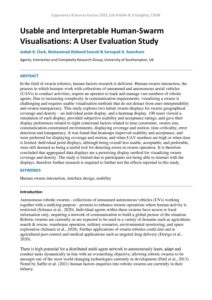| Document | Author Jediah R. Clark, Mohammad Divband Soorati & Sarvapali D. Ramchurn |
| Abstract In the field of swarm robotics, human factors research is deficient. Human-swarm interaction, the process in which humans work with collections of unmanned and autonomous aerial vehicles (UAVs) to conduct activities, require an operator to track and manage vast numbers of robotic agents. Due to increasing complexity in communication requirements, visualising a swarm is challenging and requires usable visualisation methods that do not detract from user-interpretability and swarm transparency. This study explores two initial swarm-displays for swarm geographical coverage and density – an individual point display, and a heatmap display. 100 users viewed a simulation of each display, provided subjective usability and acceptance ratings, and gave their display preferences related to eight contextual factors related to time constraints, swarm size, communication-constrained environments, displaying coverage and motion, time-criticality, error detection and transparency. It was found that heatmaps improved usability and acceptance, and were preferred for displaying coverage and motion, and when UAV numbers are high or when time is limited. Individual point displays, although being overall less usable, acceptable, and preferable, were still deemed as being a useful tool for detecting errors in swarm operation. It is therefore concluded that aggregated data displays are a promising display method for visualising swarm coverage and density. The study is limited due to participants not being able to interact with the displays, therefore further research is required to further test the effects reported in this study. |

